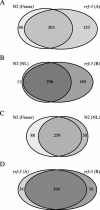Genome-wide RNAi of C. elegans using the hypersensitive rrf-3 strain reveals novel gene functions
- PMID: 14551910
- PMCID: PMC212692
- DOI: 10.1371/journal.pbio.0000012
Genome-wide RNAi of C. elegans using the hypersensitive rrf-3 strain reveals novel gene functions
Abstract
RNA-mediated interference (RNAi) is a method to inhibit gene function by introduction of double-stranded RNA (dsRNA). Recently, an RNAi library was constructed that consists of bacterial clones expressing dsRNA, corresponding to nearly 90% of the 19,427 predicted genes of C. elegans. Feeding of this RNAi library to the standard wild-type laboratory strain Bristol N2 detected phenotypes for approximately 10% of the corresponding genes. To increase the number of genes for which a loss-of-function phenotype can be detected, we undertook a genome-wide RNAi screen using the rrf-3 mutant strain, which we found to be hypersensitive to RNAi. Feeding of the RNAi library to rrf-3 mutants resulted in additional loss-of-function phenotypes for 393 genes, increasing the number of genes with a phenotype by 23%. These additional phenotypes are distributed over different phenotypic classes. We also studied interexperimental variability in RNAi results and found persistent levels of false negatives. In addition, we used the RNAi phenotypes obtained with the genome-wide screens to systematically clone seven existing genetic mutants with visible phenotypes. The genome-wide RNAi screen using rrf-3 significantly increased the functional data on the C. elegans genome. The resulting dataset will be valuable in conjunction with other functional genomics approaches, as well as in other model organisms.
Conflict of interest statement
The authors have declared that no conflicts of interest exist.
Figures

References
-
- Ashrafi K, Chang FY, Watts JL, Fraser AG, Kamath RS, et al. Genome-wide RNAi analysis of Caenorhabditis elegans fat regulatory genes. Nature. 2003;421:268–272. - PubMed
-
- Dillin A, Hsu AL, Arantes-Oliveira N, Lehrer-Graiwer J, Hsin H, et al. Rates of behavior and aging specified by mitochondrial function during development. Science. 2002;298:2398–2401. - PubMed
-
- Fire A, Xu S, Montgomery MK, Kostas SA, Driver SE, et al. Potent and specific genetic interference by double-stranded RNA in Caenorhabditis elegans . Nature. 1998;391:806–811. - PubMed
-
- Fraser AG, Kamath RS, Zipperlen P, Martinez-Campos M, Sohrmann M, et al. Functional genomic analysis of C. elegans chromosome I by systematic RNA interference. Nature. 2000;408:325–330. - PubMed
-
- Gönczy P, Echeverri C, Oegema K, Coulson A, Jones SJM, et al. Functional genomic analysis of cell division in C. elegans using RNAi of genes on chromosome III. Nature. 2000;408:331–336. - PubMed
Publication types
MeSH terms
Substances
Grants and funding
LinkOut - more resources
Full Text Sources
Other Literature Sources

